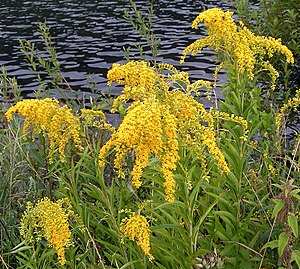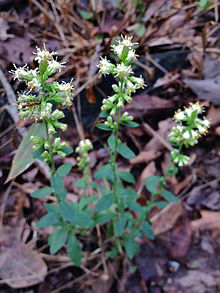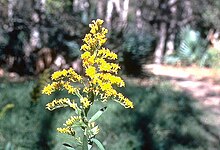Goldenrods
| Goldenrods | ||||||||||||
|---|---|---|---|---|---|---|---|---|---|---|---|---|

Giant goldenrod ( Solidago gigantea ) |
||||||||||||
| Systematics | ||||||||||||
|
||||||||||||
| Scientific name | ||||||||||||
| Solidago | ||||||||||||
| L. |
The goldenrod ( Solidago ), also gold diamonds called, are a genus within the family of the daisy family (Asteraceae). The 100 or so species are mainly found in North America .
description


Vegetative characteristics
Solidago species are perennial, herbaceous plants that reach heights of 5 to 100, rarely up to 200 centimeters. Many species form rhizomes as persistence organs. The stems are mostly upright, less often prostrate. Sometimes they are branched. The stems are usually smooth or sometimes hairy ( e.g. Solidago canadensis ). The alternate, stalked or sessile leaves are simple and smooth or hairy. The leaf margins are often serrated.
Generative characteristics
In very differently structured, often branched inflorescences, there are usually many (two to 1500) small cup-shaped partial inflorescences ; very seldom the flower heads stand individually. The flower heads are bell-shaped to cylindrical and have a diameter of 1.7 to 10 millimeters. The cup base is surrounded by ten to 35 bracts in three to five rows. In the flower head there are usually two to 15 (seldom missing or up to 24) ray florets at the edge and in the center usually two to 35 (rarely up to 60) tubular florets. The ray florets , also called ray florets are zygomorphic , female, fertile , mostly ungehaart and usually yellow or rarely white. The radially symmetrical tubular flowers , also called disc flowers, are yellow, hermaphrodite, fertile and five-toothed.
The achenes usually have eight to ten ribs. The pappus consists of 25 to 45 bristles in two rows; sometimes the bristles are also surrounded by scales 0.25 to 0.5 millimeters long.
ecology
The Solidago species are hemicryptophytes . Vegetative reproduction takes place through rhizomes .
The spread of the diaspores , it is the achenes, is done by the wind.




Systematics and distribution
The genus Solidago was established by Carl von Linné . Synonyms for Solidago L. are: Actipsis Raf. , Aster L. subg. Solidago (L.) Kuntze , Leioligo Rafinesque , Oligoneuron Small , Brachychaeta Torr. & A.Gray .
Solidago species are mainly found in North America . Few species are native to South America (four) and some in Eurasia (six to ten).
Some species were introduced into Europe about 250 years ago ( neophytes ). In Central Europe, they thrive mainly on meadows and pastures and along roads and streams. In Central Europe only the common goldenrod ( Solidago virgaurea L. ) is native. The Canadian goldenrod ( Solidago canadensis L. ) and the giant goldenrod ( Solidago gigantea Ait. Var. Serotina (Kuntze) Cronquist ) are widely naturalized . Differentiating many species is difficult.
About 100 species belong to the genus Solidago :
- Solidago albopilosa E.L. Braun : It occurs in Kentucky only in Menifee , Powell and Wolfe Counties .
- Solidago altiplanities C. & J.Taylor : It occurs in Oklahoma and Texas.
- Solidago altissima L .: It is widespread in North America.
- Solidago arguta Ait. : It is widespread in North America.
- Solidago auriculata Shuttlw. ex Blake : It is widespread in the southern United States.
- Solidago × beaudryi Boivin
- Solidago bicolor L .: It is widespread in North America.
- Solidago boottii Hook. : The home is the USA.
- Solidago brachyphylla Chapman : It is widespread in North America.
- Solidago buckleyi Torr. & Gray : It comes common in Arkansas, Illinois, Indiana, Kentucky, and Missouri.
- Solidago caesia L .: It is widespread in North America.
- Solidago calcicola Fern.
- Solidago californica Nutt.
- Canadian goldenrod ( Solidago canadensis L. ): It originates from North America and is a neophyte in Central Europe .
- Solidago cutleri Fern.
- Solidago deamii Fern.
- Solidago discoidea Ell.
- Solidago × erskinei Boivin
- Solidago fistulosa P. Mill. : It is widespread in the United States.
- Solidago flaccidifolia Small
- Solidago flexicaulis L .: It is widespread in Canada and the United States.
- Solidago gattingeri Chapman : It occurs in Arkansas, Missouri and Tennessee.
-
Late goldenrod ( Solidago gigantea Ait. ). Including:
- Giant goldenrod ( Solidago gigantea var. Serotina (Kuntze) Cronquist) : It comes from North America and is a neophyte in Central Europe.
- Solidago glomerata Michx. : It occurs in North Carolina and Tennessee.
- Solidago gracillima Torr. & Gray
- Solidago guiradonis Gray : It occurs in California.
- Solidago hispida Muhl. ex Willd. : It is widespread in Canada and the United States.
- Solidago howelllii Wooton & Standl.
- Solidago juliae Nesom : It occurs in Texas and Mexico.
- Solidago juncea Ait. : It is widespread in North America.
- Solidago latissimifolia P.Mill. : It occurs in the United States.
- Solidago leavenworthii Torr. & Gray : It is common in the southeastern US states of Alabama , Florida , Georgia , North Carolina and South Carolina .
- Solidago ludoviciana (Gray) Small : Found in Arkansas, Louisiana, and Texas.
- Solidago × lutea (MLGreen) Brouillet & Semple
- Solidago macrophylla Pursh : It is found in Canada and the northeastern United States.
- Solidago missouriensis Nutt. : It is common in North America to northern Mexico.
- Solidago mollis Bartl. : It is widespread in North America.
- Solidago multiradiata Ait. : It is widespread in North America.
- Solidago nana Nutt. : It is common in the western and southern US states of Colorado , Idaho , Montana , New Mexico , Arizona , Nevada and Utah .
- Solidago nemoralis Ait. : It is widespread in North America.
- Solidago odora Ait. : It is common from the USA to Mexico .
- Solidago ouachitensis C. & J.Taylor : The home is only Oklahoma and Arkansas .
- Solidago patula Muhl. ex Willd. : It is widespread in the USA.
- Solidago petiolaris Ait. : It is common in the United States and northern Mexico.
- Solidago pinetorum Small : It occurs in North Carolina, South Carolina and Virginia.
- Solidago plumosa Small : It occurs in North Carolina.
- Solidago porteri Small
- Solidago puberula Nutt. : It occurs in two subspecies in eastern North America.
- Solidago pulchra Small : It occurs in North Carolina.
- Solidago radula Nutt. : It occurs in Arkansas, Georgia, Illinois, Kansas, Kentucky, Louisiana, Missouri, North Carolina, South Carolina, Oklahoma, and Texas.
- Solidago × raymondii Rouss.
- Solidago roanensis Porter : It occurs in Alabama, Georgia, Maryland, North Carolina, South Carolina, Tennessee, Virginia and West Virginia.
- Solidago rugosa P. Mill. : It occurs in two subspecies and five varieties in eastern North America widespread.
- Solidago rupestris Raf. : It occurs in Indiana, Kentucky, Maryland, Pennsylvania, Tennessee, and Virginia.
- Solidago sciaphila Steele : It occurs in Illinois, Iowa, Minnesota and Wisconsin.
- Solidago sempervirens L .: It is distributed in North America from Canada to the USA to Mexico and the Bahamas .
- Solidago shortii Torr. & Gray : The home is only Indiana and Kentucky.
- Solidago simplex Kunth : It is widespread in North America in two subspecies and seven varieties.
- Solidago simulans remote.
- Solidago speciosa Nutt. : It is widespread in North America.
- Solidago spectabilis (DCEat.) Gray : It is distributed in the western US states of Idaho, Oregon, northwestern Arizona, California, Nevada and Utah.
- Solidago sphacelata Raf. : It occurs in Alabama, Georgia, Illinois, Indiana, Kentucky, Mississippi, North Carolina, Ohio, Tennessee, Virginia, and West Virginia.
- Solidago spithamea M.A.Curtis : The home is only North Carolina and Tennessee .
- Solidago squarrosa Nutt. : It is widespread in North America.
- Solidago stricta Ait. : It occurs in two subspecies in North America, Mexico, Belize and Guatemala.
- Solidago tortifolia Ell. : It occurs in Alabama, Arkansas, Florida, Georgia, Louisiana, Mississippi, North Carolina, South Carolina, Texas, and Virginia.
- Solidago uliginosa Nutt. : It is widespread in Canada and the United States.
- Solidago × ulmicaesia Friesner
- Solidago ulmifolia Muhl. : It is widespread in two varieties in North America.
- Solidago velutina DC. : It is common from the USA to Mexico.
- Solidago verna M.A.Curtis : The home is only North Carolina and South Carolina.
- Solidago Victorinii Fern.
- Common goldenrod ( Solidago virgaurea L. ): It thrives in dry forests and bushes from the arctic to the northern subtropical zone of Eurasia .
- Solidago wrightii Gray : It is distributed from the USA to Mexico.
No longer belongs to the genus:
- The genus Chrysoma Nuttall was spun off with the only species:
- Chrysoma pauciflosculosa (Michaux) Greene (Syn .: Solidago pauciflosculosa Michaux )
- The genus Euthamia (Nuttall) Cass was spun off. with five types:
- Euthamia caroliniana (L.) Britton Greene ex & Porter (Syn .: Erigeron carolinianus L. , Euthamia galetorum Greene , Euthamia media Greene , Euthamia microcephala Greene , Euthamia microphylla Greene , Euthamia remota Greene , Euthamia tenuifolia (Pursh) Nuttall , Solidago lanceolata L . var. minor Michaux , Solidago moseleyi Fernald , Solidago tenuifolia Pursh , Solidago tenuifolia var. pycnocephala Fernald )
- Grass-leaved Goldenrod ( Euthamia graminifolia (L.) Nuttall , Syn .: chrysocoma graminifolia L. , Euthamia fastigiata Bush , Euthamia floribunda Greene , Euthamia graminifolia var. Major (Michaux) Moldenke , Euthamia graminifolia var. Nuttallii (Greene) Sieren , Euthamia hirtipes ( Fernald) Sieren , Solidago camporum var. Tricostata Lunell , Solidago graminifolia (L.) Salisbury , Solidago hirtipes Fernald , Solidago lanceolata L. ), neophyte from North America, which reaches a height of 50 to 80 centimeters.
- Euthamia gymnospermoides Greene : It is widespread in North America.
- Euthamia leptocephala (Torrey & A.Gray) Greene ex Porter & Britton : It is common in the USA.
- Euthamia occidentalis Nuttall : It is distributed from Canada through the USA to Mexico.
- The genus Petradoria Greene was spun off with the only species:
- Petradoria pumila (Nuttall) Greene : The two varieties are distributed in the US states of Colorado, Idaho, Wyoming, New Mexico, Arizona, California, Nevada and Utah.
Use and miscellaneous
In phytotherapy , the drug of the flowering plant of the common goldenrod ( Solidago virgaurea ) is used as an aquatic for the (preventive) treatment of urinary stones and kidney gravel , for irritable bladder and for flushing out inflammatory diseases of the urinary tract. The drug is used as an adjuvant for rheumatic complaints. Ingredients that determine its effectiveness are flavonoids , saponins , phenylglycosides , tannins and essential oils. The lead substances are leiocarposide and virgaureoside. Solidaginis virgaurea herba has diuretic, weakly spasmolytic, anti- inflammatory , antibacterial and antioxidant effects and inhibits glutathione-S-transferase. The herb of the giant golden rod ( Solidaginis giganteae herba ) has also been used since the middle of the 20th century, but it has been less researched clinically.
In medieval texts as the Physica by Hildegard von Bingen are observed needs that time with Solidago of comfrey was meant.
A dye can be obtained from stems and leaves, depending on the concentration and stain, golden to brown-red colorations are obtained.
Goldenrods are used as garden plants in England and in the USA since the 1980s. In Germany and Switzerland they are rather unloved as neophytes , as they threaten to displace native plant species.
The goldenrod is the "national flower" of the US states Nebraska (since April 4, 1895) and Kentucky (since March 16, 1926).
In the tradition of Christianity, the yellow-blooded goldenrod is considered to be the "Laurel laurel" in memory of St. Lawrence of Rome because of its medicinal significance .
Goldenrods are suspected of causing allergic reactions such as hay fever , although the pollen from the goldenrod is heavy and sticky and cannot travel far. The pollination is primarily by insects .
Various Butterfly - larvae use gold rods as fodder plant.
swell
- John C. Semple, Rachel E. Cook: Solidago. In: Flora of North America Editorial Committee (Ed.): Flora of North America North of Mexico . Volume 20: Magnoliophyta: Asteridae, part 7: Asteraceae, part 2 (Astereae, Senecioneae). Oxford University Press, New York / Oxford a. a. 2006, ISBN 0-19-530564-7 , pp. 107 (English). , same text online as the printed work. (Sections Description and Systematics)
Individual evidence
- ↑ a b c d e f g h i j k l m n o p q r s t u v w x y z aa ab ac ad ae af ag ah ai aj Solidago in the Germplasm Resources Information Network (GRIN), USDA , ARS , National Genetic Resources Program. National Germplasm Resources Laboratory, Beltsville, Maryland. Retrieved April 25, 2014.
- ↑ a b c d e f g h i j k l m n o p q r s t u v w x y John C. Semple, Rachel E. Cook: Solidago Linnaaeus . In: Flora of North America Editorial Committee (Ed.): Flora of North America North of Mexico , Volume 20, New York and Oxford: Solidago - online.
- ↑ Cooperation Phytopharmaka : Goldenrod .
- ↑ Heinz Schilcher : Guide to Phytotherapy. Urban & Fischer, Munich 2007. ISBN 978-3-437-55348-6 . P. 113f.
- ↑ Ancient healing knowledge researched at the University of Würzburg. ( Memento from September 24, 2015 in the Internet Archive )
- ↑ Norbert Welsch, Claus Chr. Liebmann: Colors: nature, technology, art. Springer, 2012. ISBN 9783827428479 . P. 163
- ↑ Landratsamt Starnberg : Leaflet of the Lower Nature Conservation Authority for combating neophytes here: Canadian and late goldenrod (Solidago canadensis and gigantea). , August 2015.
- ↑ Goldenrod: Nebraska State Flower on statesymbolsusa.org .
- ↑ Goldenrod: Kentucky State Flower on statesymbolsusa.org .
- ^ Günther Berger: Relazioni: Internationales Wien. Peter Lang, 2009. ISBN 9783631569221 . P. 29
- ↑ J. Dvorak: Allergy and Asthma: Preventive Practice. Springer, 2013. ISBN 9783034858854 . P. 106
- ↑ Günter Ebert, Erwin Rennwald: The butterflies of Baden-Württemberg. Volume 9. Verlag Eugen Ulmer, 2003. ISBN 9783800132799 . P. 177; 185; 247
Web links
- Andy Fyon: The Solidago genus in Northern Ontario Wildflowers . (English)



